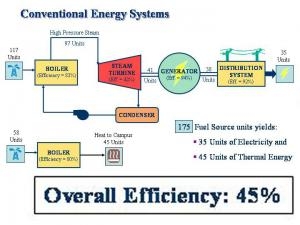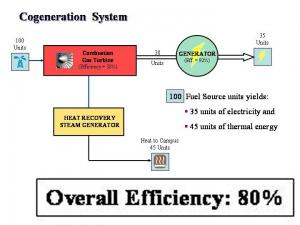Talk:Amherst College, MA Cogeneration Plant
Cogeneration Defined
Cogeneration is the simultaneous production of electricity and heat, both of which are used for beneficial purposes. A cogeneration plant is a single source for electricity and thermal energy, located close to the point of use.
The conventional approach to energy operations for a campus of Amherst College's size and complexity is to obtain all electricity from the local utility company via the "grid", at only 30% efficiency, and to generate all of the thermal needs for heat and hot water via central steam boilers. This traditional process is inherently inefficient, as shown in the diagram below, because only so much electrical energy can be derived from the energy input, and the balance is wasted as heat rejection to the atmosphere. At best, this process is 45% efficient.
The benefit of cogeneration is that locating the plant adjacent to the point of use allows for increased efficiency of energy conversion and use. The waste heat from the combustion process is captured and processed through a "heat recovery steam generator" that extracts energy from the waste heat and uses it to produce steam. The diagram below demonstrates how capturing this waste heat increases the overall efficiency to 75% or more.
General Benefits of Cogeneration
- Increased efficiency of energy conversion and use results in a significant net reduction in energy input to create an equivalent output.
- Lower emissions to the environment, in particular CO2, because less fuel is burned.
- Significant cost savings--an investment in a cogeneration plant is an attractive capital investment that has a lucrative rate of return.
- A more reliable power source. The electricity generated at the point of use is backed up by the utility grid.
- Additional steam generation capacity, which allows reduced capacity requirements for the main steam boilers.

